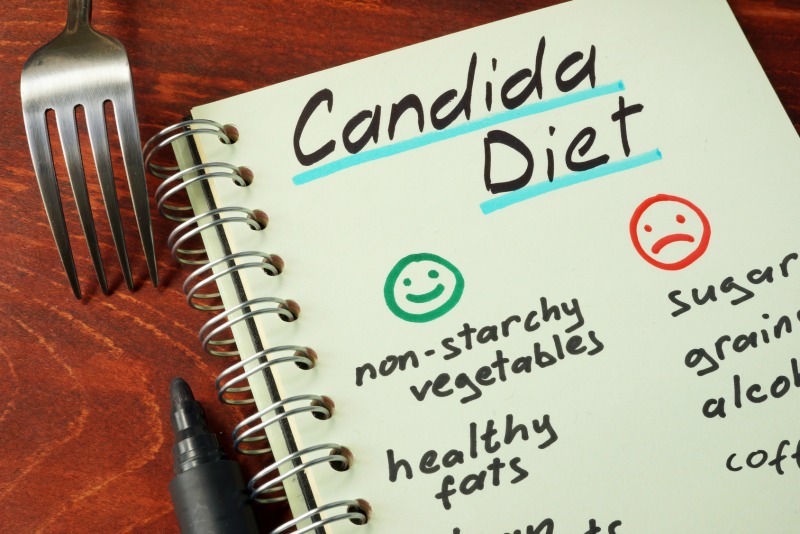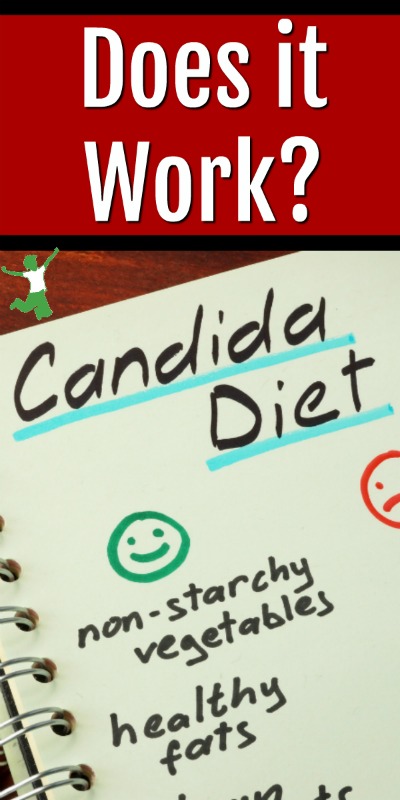Table of Contents[Hide][Show]
Review of the Candida Diet also known as the Anti-Candida Diet and why it typically does not produce desired results long-term with only short-term alleviation of symptoms.

Thinking of going on the Candida Diet to heal your gut and stop sugar and carb cravings?
While this may seem like a logical idea at first, be warned that it likely won’t heal you over the long term.
The article below explains why as well as my personal experience with it.
What is Candida Anyway?
Candida is a term that refers to a large family of yeasts, or one-celled fungi. Under normal circumstances, these organisms harmlessly inhabit the tissues of humans. This is because a balanced intestinal tract from mouth to colon contains a preponderance of beneficial bacteria that keep Candida in check.
When not enough beneficial bacteria are present in given body tissue to keep pathogenic yeasts under control, it transforms from a harmless state into an invasive species. In this rapidly growing state, Candida puts out long stringy hyphae or “roots”.
They have the ability to embed and penetrate through the gut wall and eventually cause leaky gut.
Candida overgrowth can occur in many tissues of the body. Well-known examples are oral candidiasis known as thrush, the scalp as dandruff, and vaginal yeast infections.
What Causes Fungal Overgrowth?
Candida is an opportunistic pathogen that can rapidly take over when a person is under a course of antibiotics. Antibiotics decimate beneficial gut flora but have little effect on Candida. This gives this normally harmless yeast the chance to take over dominance of the gut environment very quickly.
Many women don’t realize it, but oral contraceptives imbalance the gut in the same way as antibiotics. Again, this gives pathogenic strains of yeast an open door to take control.
A diet of processed foods high in sugars and simple carbohydrates also encourages Candida overgrowth as yeasts thrive on sugars.
Babies born via C-Section or to mothers who were treated with IV antibiotics during labor are especially vulnerable.
The reason is that they are not exposed to Mom’s healthy flora in the birth canal prior to birth.
Symptoms
Symptoms of Candida overgrowth are many the most common being fogginess in the morning upon waking (brain fog), digestive complaints of all kinds and a myriad of skin issues.
Many women plagued by yeast infections don’t realize that the source of the problem is actually their diet.
Over time, this leads to a pathogenic state in the gut environment. Using drugs and creams to resolve the problem is only a temporary solution when the source of the problem – gut imbalance – is not addressed head-on.
The Candida Diet
My husband and I tried the Candida Diet to resolve gut imbalance many years ago that had been exacerbated by our stressful and overworked lifestyle at the time.
It failed miserably!
Why?
The Candida Diet only goes part of the way in doing what is necessary to resolve gut imbalance.
It also did not include foods and supplements that help repair the intestinal damage caused by the overgrowth of pathogenic yeast.
For example, the Candida Diet removes sugar from the diet in all forms…even maple syrup and honey. Fresh fruit, however, is commonly allowed.
Candida overgrowth can frequently trigger an allergy to molds and other types of fungi. Hence, beneficial fermented foods including cheese are also eliminated along with any bread and other foods containing yeast.
Other foods excluded from the Candida Diet include vinegar, mushrooms, tea, coffee, dried fruit, and any form of fruit juices.
Temporary Improvement But No Healing
The typical scenario for a person who goes on the Candida Diet goes something like this:
- They feel better almost immediately primarily because all the sugar has been removed from their diet.
- They continue on the diet for some time perhaps many months or even a year. Pleased to see that symptoms diminish considerably during that time, they are convinced that the diet has “worked”.
- After a period of time, they try to reintroduce some of the foods that were removed. Sadly, they usually discover that their symptoms come raging back with full force.
- They realize that it is going to be next to impossible to continue the Candida Diet indefinitely. It is simply too hard to give up cheese and any and all sweets forever.
- They get discouraged, give up and stop the Candida Diet for good.
3 Reasons Why the Candida Diet Fails
The paradox of the Candida Diet is that symptoms greatly diminish. However, the patient doesn’t actually heal from the root cause of the problem which is a breach in the integrity of the gut lining.
Long-term healing is prevented on the Anti-Candida Diet for the following key reasons:
Reason #1
The Candida Diet allows starchy vegetables and tubers like sweet potato, cassava, yams, and arrowroot.
Note that some anti-candida diet practitioners recommend caution with these foods, but others do not.
Reason #2
The Candida Diet doesn’t include a small cup of traditional bone broth with every single meal. This is an incredibly necessary food for proper healing/sealing of the gut wall caused by candida overgrowth.
For more severe cases, short-cooked meat stock needs to be used and NOT bone broth. Some people cannot tolerate the glutamate in long-cooked broths.
Long-term gut healing is quite simply NOT going to occur without using the correct form of stock or broth.
Thus, any candida diet benefits will usually be temporary.
Reason #3
More important than the allowance of starch in the Candida Diet is the inclusion of grain-based foods. Some practitioners recommending the Candida Diet misguidedly include gluten-free grains.
Others recommend none at all (in an apparent scramble to mimic diets that actually work to fix the gut like GAPS and to a lesser extent the bone broth diet).
The bottom line is that there is no uniformity to what is recommended, hence, the protocol’s unreliability in providing relief over the long-term.
Anti-Candida Diet Shortfall
Even if the Candida Diet is used in conjunction with a gluten-free, casein-free diet, it fails in the majority of instances.
The reason is that disaccharides, or double sugars, are present in many carbohydrates including ALL grains – not just gluten-containing ones.
An inflamed, imbalanced gut overridden with Candida is unable to digest double sugar molecules completely. This occurs because the lack of beneficial gut flora has compromised the function of the enterocytes.
According to Dr. Natasha Campbell-McBride MD, author of Gut and Psychology Syndrome and one of the key scientists at the forefront of gut restoration research today, the enterocytes are the cells that reside on the villi of the gut wall and produce the enzyme disaccharidase.
This enzyme breaks down the disaccharide molecule into easily absorbed monosaccharide molecules.
When the enterocytes are not nourished and strengthened properly by adequate beneficial flora, they become weak and diseased and may even turn cancerous. They do not perform their duties of digesting and absorbing food properly.
Undigested Food Nourishes Pathogenic Yeast
Weak and diseased enterocytes also have trouble digesting starch molecules. They are very large with hundreds of mono sugars connected in long branchlike strands.
People with weak digestion due to Candida overgrowth and messed up enterocytes have a terrible time digesting these complex molecules.
The result is a large amount of undigested starch in the gut. The putrefying matter is the perfect food for pathogenic yeasts, bacteria, and fungi like Candida to thrive upon.
Even the starch that manages to get digested results in molecules of maltose, which is — you guessed it — a disaccharide! This maltose also goes undigested due to a lack of the enzyme disaccharidase and becomes additional food for Candida.
Biggest Candida Diet Benefit
We’ve established that the Candida Diet usually fails miserably in resolving gut imbalance problems over the long haul.
However, it does include and recommend one fantastic herb that is very helpful for keeping Candida under control if only temporarily…Pau d’Arco tea.
I’ve found this herb is especially helpful during traveling (when the diet is less than optimal) or for a few days after you get home to get back on the wagon.
What is the Best Diet for Candida?
In conclusion, it is best not to waste your time with the Candida Diet. It doesn’t work in the majority of cases and you will ultimately feel frustrated in your efforts to heal over the long term.
The best diets for healing and sealing the gut wall and permanently rebalancing the gut environment are the GAPS Diet or the very similar SCD (Specific Carbohydrate) Diet.
To read more about the GAPS Diet and what the food list includes, check out this introductory post on using GAPS to heal autoimmune disease.
Also, this post The Five Most Common GAPS Diet Mistakes is a review of the most common pitfalls of this approach to gut healing.

Reference
Gut and Psychology Syndrome, Dr. Natasha Campbell-McBride MD
More Information
Macrobiotic Diet and Extreme Vitamin D Deficiency
Biofilms: Overlooked Step in Treating Candida
Can Candida Sufferers Drink Kombucha?
How to Take Probiotics








Sarah, are fermented drinks allowed during the Intro GAPS diet? I wasn’t sure. If so, do you know when they are ok to introduce?
Very timely article – going thru exactly what you said, with the symptoms coming back in full force. Looks like it’s GAPS for me…
I can see why that candida diet would never work with fruit, potatoes & grains. Yikes. The candida diet I followed was spartan with zero sugars except for those found naturally in low carbs veggies (no mushrooms). In addition, the candida must be killed using coconut oil, olive leaf oil, garlic, etc.
@Iyisa Strawberry tongue is a red tongue. The tongue in the post is oral candidiasis or thrush. Here is a picture of strawberry tongue: http://en.wikipedia.org/wiki/File:Scharlach.JPG
there IS some great info in the article, don’t get me wrong. 🙂 i’ve also researched the GAPS diet for healing the gut which seems the best route to go for years and years of damage…
Eating “normally” would be eating a sweets (made with whole sugars) in moderation, as well as fruits, grains (properly prepared) and starches without Candida symptoms coming back full fury as what happens after a stint on the Candida Diet as it doesn’t heal .. only addresses symptoms.
also: “Avoid starchy vegetables such as sweet potatoes, potatoes, yams, corn, all winter squash, beets, peas, parsnips and all beans except green beans.” for stage 2 during the candida diet… DEFINITELY different info than given in your article here…..
also: “Avoid starchy vegetables such as sweet potatoes, potatoes, yams, corn, all winter squash, beets, peas, parsnips and all beans except green beans.” for stage 2 during the candida diet… DEFINITELY different info than given in your article here…..
Yes, honey is ok on GAPS. Honey is not a disaccharride and can be digested completely even if gut function is compromised. This is another less serious flaw of the Candida Diet as honey is not allowed.
WRONG.